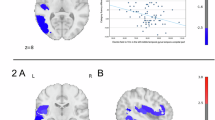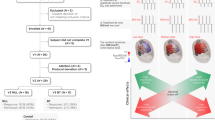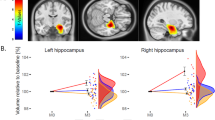Abstract
Despite ongoing controversy, there has never been a large-scale, prospective study of the cognitive effects of electroconvulsive therapy (ECT). We conducted a prospective, naturalistic, longitudinal study of clinical and cognitive outcomes in patients with major depression treated at seven facilities in the New York City metropolitan area. Of 751 patients referred for ECT with a provisional diagnosis of a depressive disorder, 347 patients were eligible and participated in at least one post-ECT outcome evaluation. The primary outcome measures, Modified Mini-Mental State exam scores, delayed recall scores from the Buschke Selective Reminding Test, and retrograde amnesia scores from the Columbia University Autobiographical Memory Interview–SF (AMI–SF), were evaluated shortly following the ECT course and 6 months later. A substantial number of secondary cognitive measures were also administered. The seven sites differed significantly in cognitive outcomes both immediately and 6 months following ECT, even when controlling for patient characteristics. Electrical waveform and electrode placement had marked cognitive effects. Sine wave stimulation resulted in pronounced slowing of reaction time, both immediately and 6 months following ECT. Bilateral (BL) ECT resulted in more severe and persisting retrograde amnesia than right unilateral ECT. Advancing age, lower premorbid intellectual function, and female gender were associated with greater cognitive deficits. Thus, adverse cognitive effects were detected 6 months following the acute treatment course. Cognitive outcomes varied across treatment facilities and differences in ECT technique largely accounted for these differences. Sine wave stimulation and BL electrode placement resulted in more severe and persistent deficits.
Similar content being viewed by others
Log in or create a free account to read this content
Gain free access to this article, as well as selected content from this journal and more on nature.com
or
References
Abrams R (1986). Is unilateral electroconvulsive therapy really the treatment of choice in endogenous depression? Ann NY Acad Sci 462: 50–55.
Abrams R (2002). Electroconvulsive Therapy. Oxford University Press: New York.
American Psychiatric Association (2001). The Practice of ECT: Recommendations for Treatment, Training and Privileging, 2nd edn. American Psychiatric Press: Washington, DC.
Andrade C, Gangadhar BN, Subbakrishna DK, Channabasavanna SM, Pradhan N (1988). A double-blind comparison of sinusoidal wave and brief-pulse electroconvulsive therapy in endogenous depression. Convulsive Ther 4: 297–305.
Ballard JC (1997). Computerized assessment of sustained attention: a review of factors affecting vigilance performance. J Clin Exp Neuropsychol 18: 843–863.
Benton AL (1977). Interactive effects of age and brain disease on reaction time. Arch Neurol 34: 369–370.
Benton AL, Blackburn HL (1957). Practice effects in reaction-time tasks in brain-injured patients. J Abnorm Soc Psychol 54: 109–113.
Breggin PR (1986). Neuropathology and cognitive dysfunction from ECT. Psychopharm Bull 22: 476–479.
Buschke H (1973). Selective reminding for analysis of memory and learning. J Verbal Learning Verbal Behav 12: 543–550.
Calev A, Gaudino EA, Squires NK, Zervas IM, Fink M (1995). ECT and non-memory cognition: a review. Br J Clin Psychol 34 (Part 4): 505–515.
Carney M, Sheffield B (1974). The effects of pulse ECT in neurotic and endogenous depression. Br J Psychiatry 125: 91–94.
Cornblatt BA, Lenzenweger MJ, Erlenmeyer-Kimling L (1984). The continuous performance test, identical pairs version: Contrasting attentional profiles in schizophrenic and depressed patients. J Psychiatr Res 29: 66–85.
Donahue AB (2000). Electroconvulsive therapy and memory loss: a personal journey. J ECT 16: 133–143.
Farah A, McCall WV (1993). Electroconvulsive therapy stimulus dosing: a survey of contemporary practices. Convulsive Ther 9: 90–94.
Fink M (2004). Electroshock: Healing Mental Illness. Oxford University Press: New York.
First MB, Spitzer RL, Gibbon M, Williams JBW (1996a). Structured Clinical Interview for Axis I DSM-IV Disorders—Patient Edition (with Psychotic Screen) (SCID-I/P). Biometrics Research Department, New York State Psychiatric Institute: New York.
First MB, Spitzer RL, Gibbon M, Williams JBW, Benjamin L (1996b). Structured Clinical Interview for DSM-IV Axis II Personality Disorders (SCID-II). Biometrics Research Department, New York State Psychiatric Institute: New York.
Folstein MF, Folstein SE, McHugh PR (1975). Mini-mental state. J Psychiatr Res 12: 189–198.
Hamilton M (1967). Development of a rating scale for primary depressive illness. Br J Soc Clin Psychol 6: 278–296.
Hannay HJ, Levin HS (1985). Selective reminding test: an examination of the equivalence of four forms. J Clin Exp Neuropsychol 7: 251–263.
Johnstone B, Callahan CD, Kapila CJ, Bouman DE (1996). The comparability of the WRAT-R reading test and NAART as estimates of premorbid intelligence in neurologically impaired patients. Arch Clin Neuropsychology 11: 513–519.
Lancaster NP, Steinert RR, Frost I (1958). Unilateral electroconvulsive therapy. J Ment Sci 104: 221–227.
Lisanby SH, Maddox JH, Prudic J, Devanand DP, Sackeim HA (2000). The effects of electroconvulsive therapy on memory of autobiographical and public events. Arch Gen Psychiatry 57: 581–590.
MacLeod CM (1991). Half a century of research on the Stoop effect: an integrative review. Psychol Bull 109: 163–203.
McCall WV, Reboussin DM, Weiner RD, Sackeim HA (2000). Titrated moderately suprathreshold vs fixed high-dose right unilateral electroconvulsive therapy: acute antidepressant and cognitive effects. Arch Gen Psychiatry 57: 438–444.
McElhiney M, Moody B, Sackeim H (1997). The Autobiographical Memory Interview—Short Form. New York State Psychiatric Institute: New York.
McElhiney MC, Moody BJ, Steif BL, Prudic J, Devanand DP, Nobler MS et al (1995). Autobiographical memory and mood: effects of electroconvulsive therapy. Neuropsychology 9: 501–517.
Miller MD, Paradis CF, Houck PR, Mazumdar S, Stack J, Rifai AH et al (1992). Rating chronic medical illness burden in geropsychiatric practice and research: application of the Cumulative Illness Rating Scale (CIRS). Psychiatry Res 41: 237–248.
Ottosson J-O (1960). Experimental studies of the mode of action of electroconvulsive therapy. Acta Psychiatr Scand (Suppl) 145: 1–141.
Prudic J, Olfson M, Marcus SC, Fuller RB, Sackeim HA (2004). Effectiveness of electroconvulsive therapy in community settings. Biol Psychiatry 55: 301–312.
Prudic J, Olfson M, Sackeim HA (2001). Electro-convulsive therapy practices in the community. Psychol Med 31: 929–934.
Rey A (1941). L'examen psychologique dans les cas d'encephalopathie traumatique. Arch Psychol 28: 286–340.
Sackeim HA (1992). The cognitive effects of electroconvulsive therapy. In: Moos WH, Gamzu ER, Thal LJ (eds). Cognitive Disorders: Pathophysiology and Treatment. Marcel Dekker: New York. pp 183–228.
Sackeim HA (2000). Memory and ECT: from polarization to reconciliation. J ECT 16: 87–96.
Sackeim HA (2004a). Electroconvulsive therapy in late-life depression. In: Roose SP, Sackeim HA (eds). Late-Life Depression. Oxford University Press: New York. pp 241–278.
Sackeim HA (2004b). The convulsant and anticonvulsant properties of electroconvulsive therapy: towards a focal form of brain stimulation. Clin Neurosci Rev 4: 39–57.
Sackeim HA, Decina P, Prohovnik I, Malitz S (1987). Seizure threshold in electroconvulsive therapy. Effects of sex, age, electrode placement, and number of treatments. Arch Gen Psychiatry 44: 355–360.
Sackeim HA, Freeman J, McElhiney M, Coleman E, Prudic J, Devanand DP (1992). Effects of major depression on estimates of intelligence. J Clin Exp Neuropsychol 14: 268–288.
Sackeim HA, Portnoy S, Neeley P, Steif BL, Decina P, Malitz S (1986). Cognitive consequences of low-dosage electroconvulsive therapy. Ann NY Acad Sci 462: 326–340.
Sackeim HA, Prudic J, Devanand DP, Kiersky JE, Fitzsimons L, Moody BJ et al (1993). Effects of stimulus intensity and electrode placement on the efficacy and cognitive effects of electroconvulsive therapy. N Engl J Med 328: 839–846.
Sackeim HA, Prudic J, Devanand DP, Nobler MS, Lisanby SH, Peyser S et al (2000). A prospective, randomized, double-blind comparison of bilateral and right unilateral electroconvulsive therapy at different stimulus intensities. Arch Gen Psychiatry 57: 425–434.
Scott AI, Rodger CR, Stocks RH, Shering AP (1992). Is old-fashioned electroconvulsive therapy more efficacious? A randomised comparative study of bilateral brief-pulse and bilateral sine-wave treatments. Br J Psychiatry 160: 360–364.
Sobin C, Sackeim HA, Prudic J, Devanand DP, Moody BJ, McElhiney MC (1995). Predictors of retrograde amnesia following ECT. Am J Psychiatry 152: 995–1001.
Spreen O, Strauss E (1998). A Compendium of Neuropsychological Tests: Administration, Norms, and Commentary. Oxford University Press: New York.
Squire L (1986). Memory functions as affected by electroconvulsive therapy. Ann NY Acad Sci 462: 307–314.
Sterling P (2000). ECT damage is easy to find if you look for it. Nature 403: 242.
Stern Y (2002). What is cognitive reserve? Theory and research application of the reserve concept. J Int Neuropsychol Soc 8: 448–460.
Stern Y, Gurland B, Tatemichi TK, Tang MX, Wilder D, Mayeux R (1994). Influence of education and occupation on the incidence of Alzheimer's disease. JAMA 271: 1004–1010.
Stern Y, Sano M, Pauson J, Mayeux R (1987). Modified mini-mental status examination: validity and reliability. Neurology 37 (Suppl 1): 179.
Sternberg DE, Jarvik ME (1976). Memory function in depression: improvement with antidepressant medication. Arch Gen Psychiatry 33: 219–224.
Valentine M, Keddie K, Dunne D (1968). A comparison of techniques in electro-convulsive therapy. Br J Psychiatry 114: 989–996.
Weiner RD, Rogers HJ, Davidson JR, Squire LR (1986). Effects of stimulus parameters on cognitive side effects. Ann NY Acad Sci 462: 315–325.
Zakzanis KK, Leach L, Kaplan E (1998). On the nature and pattern of neurocognitive function in major depressive disorder. Neuropsychiatry Neuropsychol Behav Neurol 11: 111–119.
Zervas IM, Calev A, Jandorf L, Schwartz J, Gaudino E, Tubi N et al (1993). Age-dependent effects of electroconvulsive therapy on memory. Convulsive Ther 9: 39–42.
Acknowledgements
This work was supported in part by Grants R01 MH59069, R01 MH35636, R01 MH61609, and R01 MH05148 from the National Institute of Mental Health, Bethesda, MD, USA. We thank Dr Bernard Lerer for his comments on this work, and the staff at the seven hospitals who facilitated the conduct of this study.
Author information
Authors and Affiliations
Corresponding author
Rights and permissions
About this article
Cite this article
Sackeim, H., Prudic, J., Fuller, R. et al. The Cognitive Effects of Electroconvulsive Therapy in Community Settings. Neuropsychopharmacol 32, 244–254 (2007). https://doi.org/10.1038/sj.npp.1301180
Received:
Revised:
Accepted:
Published:
Issue date:
DOI: https://doi.org/10.1038/sj.npp.1301180
Keywords
This article is cited by
-
A randomized sham-controlled trial of high-dosage accelerated intermittent theta burst rTMS in major depression: study protocol
BMC Psychiatry (2024)
-
Electroconvulsive therapy in Oman: a national audit of demographics and standards
Middle East Current Psychiatry (2023)
-
Recipients’ experience with information provision for electroconvulsive therapy (ECT)
BMC Psychiatry (2022)
-
How Do People Perceive and Adapt to Any Consequences of Electro Convulsive Therapy on Their Daily Lives?
Community Mental Health Journal (2022)
-
ECT-induced cognitive side effects are associated with hippocampal enlargement
Translational Psychiatry (2021)



